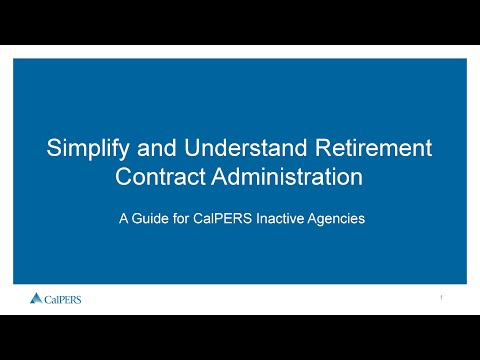Pension Contracts Inactive Agencies
Additional Questions & Information
For questions or additional information about inactive agency pension contracting and funding options, contact the Pension Contracts Management Program at PensionContracts@calpers.ca.gov or (916) 795-1024, or your assigned actuary at 888 CalPERS (or 888-225-7377).
What Is an Inactive Agency?
An inactive agency no longer has active employees and doesn't report payroll but is still contracted with CalPERS and responsible for funding the retirement and death benefits of its CalPERS retirees, beneficiaries, and those who elected to leave their contributions on deposit with CalPERS.
Agencies become inactive for various reasons, most commonly through reorganizations, mergers, dissolutions, or outsourcing of services. Find more detailed descriptions and common examples of how agencies become inactive.
A dissolution means an agency ceases to exist. A successor agency takes over providing services but in some instances the pension obligations do not transfer to the successor agency’s pension contract and remain under the dissolved agency. Typically, the successor agency manages the dissolved agency’s leftover funds to ensure its pension obligations remain funded.
A reorganization is one or more functions of an agency transferring to another new or existing agency, but the pension and retirement obligations remain with the original agency. Whether an employee class or whole department, the agency is no longer reporting active employees and becomes an inactive agency for this portion of their pension and retirement obligations.
A consolidation is two or more agencies uniting or joining into a single new successor agency. If the successor agency does not take on the existing pension and retirement obligations, the original agency then becomes an inactive agency as it is no longer reporting active employees but still responsible for funding its existing pension and retirement obligations.
A merger is one agency ceasing to exist and its functions, services, assets, and liabilities are taken over by another agency. In some circumstances, the pension and retirement obligations remain on the dissolving agency’s CalPERS contract and the inactive agency is still responsible for funding its existing pension and retirement obligations.
For various reasons, an agency may decide to stop providing services and outsource to another entity. In this circumstance, the agency remains in existence but has no active employees to report because its operations are outsourced. The agency remains responsible for funding the pension and retirement benefits of its employees prior to the date of outsourcing.
An agency may stop employee reporting for other reasons not listed previously and become an inactive agency where it may no longer provide a service or be in operation but retains responsibility for funding its existing pension and retirement obligations.
Ongoing Pension Obligations
Inactive agencies are still responsible for funding the promised retirement benefits of their retirees. There are no normal costs as inactive agencies do not have active employees to report. However, an unfunded accrued liability (UAL) is owed if the agency’s plan is not fully funded.
An inactive agency’s UAL can vary in any given year if the agency’s actual experience varies from what the actuarial assumptions dictate. Some examples of actual experience being different from assumptions include, but are not limited to, investment returns, inflation, or mortality. When this happens, a course correction is built into the UAL payment for the agency in that year. Visit our Managing the Unfunded Accrued Liability page for more information.
Inactive agencies are billed monthly for required contribution amounts. An alternative to making monthly payments is to make an annual UAL lump-sum prepayment during the month of July. If a UAL lump-sum prepayment is not made in July then the plan’s annual UAL costs are billed in monthly payments. If an agency does not pay the entire amount invoiced on or before the due date, a 10% delinquency penalty may be imposed on all delinquent balances and interest will be assessed on 100% of the outstanding invoice amount past due until the amount is paid in full. Interest is charged at an annual rate of 10% per Government Code section 20572(b) of the Public Employees’ Retirement Law (PERL).
Reviewing your annual actuarial valuation is critical to knowing your plan's funded status and impact to annual UAL payments. Even if your agency is fully funded, review the valuation report annually so you are aware of any year-to-year changes to your funded status.
The Pension Outlook Tool is available to estimate your agency’s future pension costs across different investment return and plan experience scenarios.
For many inactive agencies, funding UAL is a critical challenge. If your inactive agency is struggling with sustaining its required UAL payments, the CalPERS Pension Contracts Management Program and Actuarial Office are available to discuss your challenges and provide you options before you fall into payment delinquency and incur additional fees. For assistance contact PensionContracts@calpers.ca.gov or (916) 795-1024, or your assigned actuary at 888 CalPERS (or 888-225-7377).
Hiring New Employees
If an inactive agency restarts operations and hires new employees, it must notify the Actuarial Office before new employee payroll reporting may occur.
Additional Resources
The CalPERS Pension Contracts Management Program and Actuarial Office are available to discuss and inform all CalPERS contracted agencies on their pension contracting and funding options. Additionally, find relevant and important resources for all our contracting agencies:

